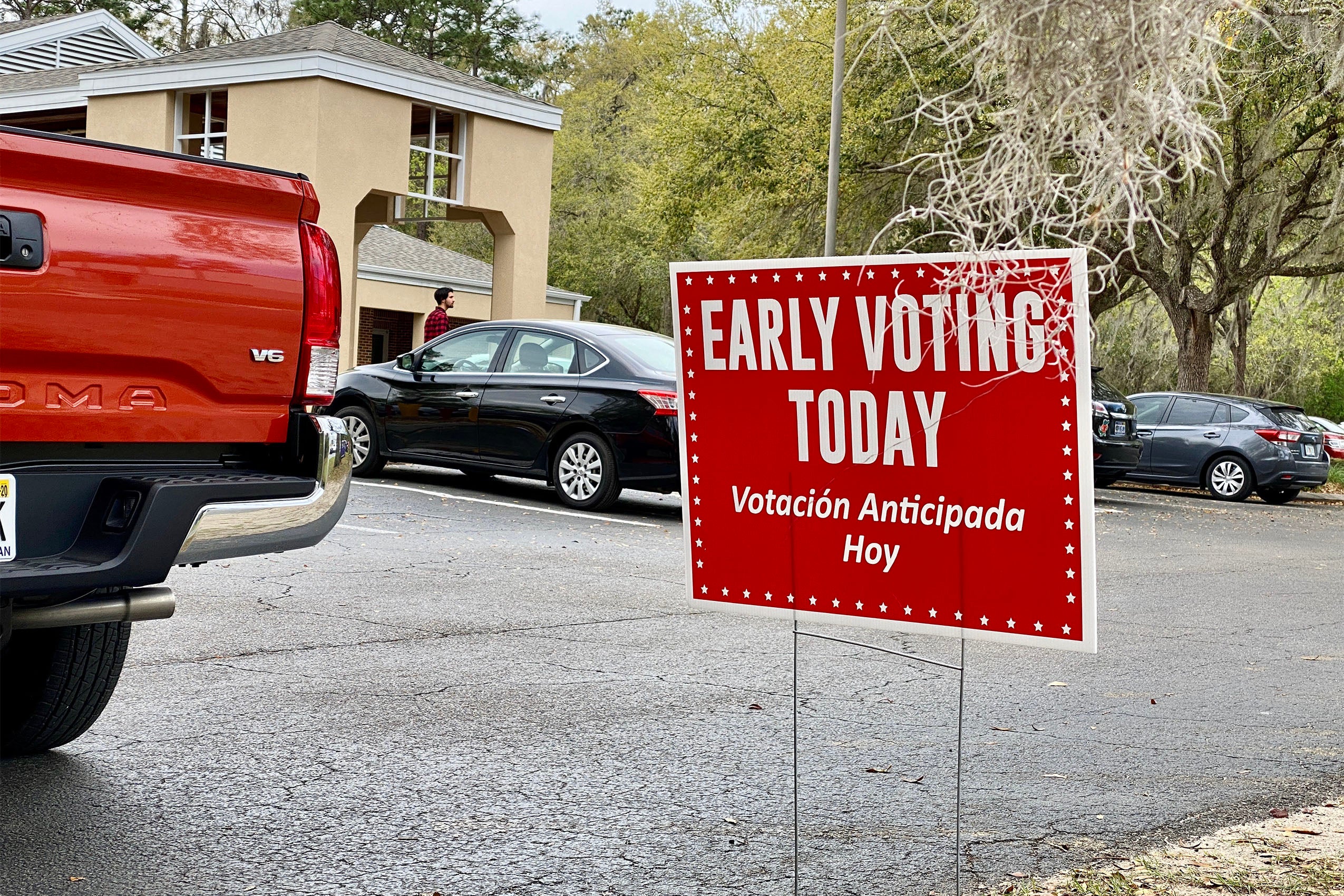On July 1, the Supreme Court issued its decision in Brnovich v. Democratic National Committee, a case voting rights advocates say has critical implications for the future of American suffrage. At issue was whether a pair of laws enacted in Arizona — one that does not count provisional ballots cast outside a voter’s precinct, and another that bars so-called “ballot-harvesting” — violated Section 2 of the Voting Rights Act due to their disparate impact on minority voters. The 6-3 opinion, authored by Associate Justice Samuel Alito, upheld the Arizona laws, but also rolled out a new five-factor test to determine when such “time, place, and manner” voting restrictions might contravene the Voting Rights Act.
Nicholas Stephanopoulos, Kirkland & Ellis Professor of Law, spoke with Harvard Law Today about the decision, options for advocates moving forward, and the future of the Voting Rights Act.
Harvard Law Today: What are your thoughts on the decision?
Nicholas Stephanopoulos: Number one, it’s an embarrassment for the conservative justices who joined it. The modern conservative justices brag about how textualist they are; they brag that they start with the text and end with the text of the law in interpreting it. But the Court’s opinion here is largely non-textual. The court makes up this sequence of five factors that lower courts should use in the future to decide cases about voting restrictions, and none of the factors are anywhere in the text of the statute. They’re basically plucked out of thin air.
Second, what’s motivating the Court is clearly just ideological discomfort. The mission of the Voting Rights Act is to be inclusive toward minority voters, to enable minority voters to vote and to participate, with the same odds of success as non-minority voters. That’s an aggressive, radical mission. The point of the Voting Rights Act is to change American democracy — not to leave it the way it is. And the conservatives on the Court have zero interest and a visceral dislike for that mission. They don’t want the federal government making voting easier. They want states to retain their ability to restrict voting however they want. They’re uncomfortable with talk about racial disparities, racial motives.

And going forward after this decision, it’s going to be quite difficult for plaintiffs to win voting rights cases. Of the five factors that the Court invented, every single one of them is anti-plaintiff and pro-defendant. Strangely, for one of these factors, it suddenly matters whether some electoral practice was common in 1982, when Section 2 of the Voting Rights Act was written in its current form. Since 1982, almost every state in the country has liberalized voting. That means that the Court will give restrictions a pass as long as they don’t make it harder to vote than it was in 1982. With that bizarre 1982 benchmark in place, it’s going to be really difficult for plaintiffs to win, unless states invent new draconian restrictions that have never existed in the past.
HLT: You wrote a 2019 Yale Law Journal article proposing a legal standard for voting rights disparate impact cases, and a version of your argument was submitted as an amicus brief in Brnovich. As it turns out, Justice Stephen Breyer [’64] referenced your proposal during oral arguments, but it was rejected by Justice Alito in his majority opinion in favor of the new five-factor test. Can you tell me a bit about your proposed standard, and how it differs from the one adopted by the majority?
Stephanopoulos: The insight I had was that the Voting Rights Act is just another disparate racial impact statute, much like the disparate impact statutes that exist involving employment, housing, and disabilities. In all those other areas, there is a single legal framework that applies: the plaintiff must prove that a particular practice causes a significant racial disparity, and then the defendant has the opportunity to show that the practice is necessary to achieve a substantial state interest. My argument was that we could use the exact same approach in the voting context.
It was very gratifying to see the justices engaging with my idea at oral argument and in the opinion itself, but ultimately disappointing — not surprising, but still disappointing — that the Court chose to go in a different direction. What I thought was particularly revealing was the reason the Court’s majority disagreed with my approach: It said the rest of disparate impact law was too “pro-plaintiff.”
HLT: As you have said, the “five factor” test lays out what lower courts should consider in future suits challenging voting restrictions based on disparate impact. Does the test offer any hope for voting rights advocates?
Stephanopoulos: What’s good about the Court’s test is that it’s five factors to be considered, in some sort of indeterminate way, by a lower court. It is a multifactor, totality of circumstances test. It still leaves a lot of flexibility for a lower court to say “we heavily weighed factors one and two, we discount factors three and four, and that’s why we come up with the conclusion we come up with.” That means that progressive lower courts could, without straining too hard, find a way to rule in favor of plaintiffs.
Of the five factors, the ones I have the most empathy for are the ones about the size of the disparity, and the strength of the state interest. Because the point of the Voting Rights statute is to eliminate racial disparities, it should matter how significant the racial disparities are. I think it also matters that there be an important state interest for a law — like the efficient running of elections, preventing hacking, and so on. When racial disparities are properly justified, they’re not as concerning.
HLT: Speaking of legitimate state interests, the majority opinion says legislatures may be justified in passing laws intended to curb voter fraud. But how does this reasoning fit with the lack of evidence of voter fraud in recent elections?
Stephanopoulos: To be blunt, everyone knows that the voter fraud argument is just a lie. Everyone who is informed about these issues knows that there are infinitesimal amounts of voter fraud today. The real goal is to suppress turnout from poor people, minority people, and Democrats. It’s always Republicans passing these restrictive measures that always happen to target Democratic voters.
This case again shows the partisanship of the Court. They’re perfectly aware that these Republican measures are both anti-democratic, and also “big-D” anti-Democratic. The fraud argument is a facade to pretend that there is some nonpartisan justification for the measures. In my mind the right analysis is this: Fraud in theory could be a strong governmental interest, but a state has to show there actually is a worry about a particular kind of fraud in the jurisdiction. There have been times in American history where there was a real legitimate concern about fraud, but fortunately in modern America, there’s virtually no place where there is widespread fraud.
HLT: There are now a host of bills across the country aimed at restricting voting — or preventing voter fraud, depending on one’s perspective. Given Brnovich, are these laws likely to survive judicial scrutiny?
Stephanopoulos: I think they mostly will, especially given the 1982 benchmark. Lots of recent Voting Rights Act cases have involved limits to early voting or to mail-in voting. Both of those practices were more limited or didn’t exist back in 1982. After this decision, if you’re limiting a form of voting that didn’t even exist in 1982, there’s probably no way that can be illegal under the Court’s test. So I think that the Court’s five-factor test knocks out a pretty big swath of litigation that involves early voting or mail-in voting.
I think more generally that the tone of the Court’s decision is going to encourage conservative lower courts to rule against all challenges of this kind. A lot of states that are passing these voting restrictions are in conservative federal circuits. I think, after this decision, it’s going to be virtually impossible for plaintiffs to challenge any of Texas’s voting restrictions in the 5th Circuit. And the same point holds for Florida and Georgia in the 11th Circuit. I think that in many parts of the country, the Voting Rights Act will become close to a dead letter at this point.
HLT: What do you think will happen with the Justice Department’s lawsuit against voting restrictions in Georgia under Senate Bill 202?
Stephanopoulos: What’s interesting is that the Justice Department only accused Georgia of racially discriminatory intent. The whole test we’ve been talking about involves striking down some voting regulation because of its effect, not because of its intent. The trouble for the DOJ with their pending case is that you have to prove racially discriminatory intent. And conservative courts, including the Supreme Court, have basically shown themselves to think that almost nothing amounts to racially discriminatory intent. In Brnovich, for example, there was a little two-page discussion at the very end of the opinion, where the Supreme Court says, “Oh, and by the way, the Ninth Circuit found racially discriminatory intent on the part of Arizona, but we disagree, that wasn’t racial intent.” That doesn’t have any clear legal consequences for the Georgia case, but it shows the general hostility of conservative courts to ever conclude that anything in 2021 has racially discriminatory intent.
HLT: What should voting rights advocates do next?
Stephanopoulos: The universe of options is steadily shrinking. There’s a claim under the Constitution, as opposed to under the Voting Rights Act, that some voting restriction is overly onerous, or that it makes voting too difficult. But the trouble is the same conservative judges who dislike the Voting Rights Act also dislike that constitutional theory. I think when it comes to litigation, we’re running out of plausible options for plaintiffs.
So what can be done? Federal legislative action is a clean, powerful fix. Brnovich was just a decision involving a federal statute. In theory, if Congress doesn’t like a court ruling about a federal statute, all Congress has to do is change the statute. And there’s talk of doing that on Capitol Hill, but of course, that runs into the filibuster. The other thing that can be done, forgetting the law entirely, is political mobilization. We might not be able to remove these restrictions, but we can blunt their impact by mobilizing people and educating people.
HLT: A few of the Court’s decisions this cycle ended with majorities that included a surprising mix of conservatives and liberals, yet this case had a decidedly ideological split. Why do you think that was?
Stephanopoulos: You sometimes get the supermajority on the court splintering on issues that don’t present a familiar conservative hobbyhorse. When issues come up that don’t have a clear Republican position, different conservative justices have different instincts. You also sometimes get the conservatives splintering when you have an overly aggressive right-wing litigant who’s pushing the Court to go too far.
Voting rights, tragically, have become part of the entrenched left-right axis of the Court. In all of the big Roberts Court election law rulings of the last two decades, the conservatives have stuck together: Shelby County striking down the other half of the Voting Rights Act; Citizens United striking down regulations of money in politics; Crawford allowing Indiana to have a voter ID law. Basically, whenever it’s a voting issue, you have the conservatives marching in lockstep in opposition to voting rights and in favor of the state’s ability to do whatever it wants when it comes to regulating elections. Unless the state wants to curb the flow of campaign money, in which case the conservatives all unite to say it can’t do that.
